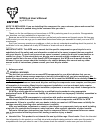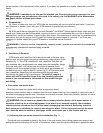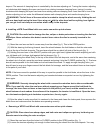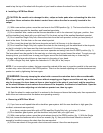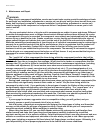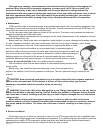
BPSA-OM#9-2A
3. Maintenance and Repair
WARNING:
Many bicycle component installation, service and repair tasks require special knowledge and tools.
Do not begin any installation, adjustments or service on your bicycle until you have learned from your
dealer how to properly complete it. Improper installation, configuration, adjustment or service may
result in damage to the component or component failure. Component failure can cause you to lose
control and fall.
BPSA-OM9-5
Like any mechanical device, a bicycle and its components are subject to wear and stress. Different
materials and mechanisms wear or fatigue from stress at different rates and have different life cycles.
If a component’s life cycle is exceeded, the component can suddenly and catastrophically fail, causing
serious injury or death to the rider. Creaks, scratches, cracks, fraying and discoloration are signs of
stress-caused fatigue and indicate that a part is at the end of its useful life and needs to be replaced.
While the materials and workmanship of your bicycle or of individual components may be covered by a
warranty for a specified period of time by the manufacturer, this is no guarantee that the product will
last the term of the warranty. Product life is often related to the kind of riding you do and to the
treatment to which you submit the bicycle and its components. The warranty is not meant to suggest
that the bicycle or a component cannot be broken or will last forever. It only means that the bicycle or
component is covered subject to the terms of the warranty.
BPSA-om9-5A
The “useful life” of this component (the time during which the component is safe to ride) will be
reduced if (1) you use it more than the average user; (2) you are heavier than the average rider; (3) the
terrain/roads you ride on is rougher than average; (4) you tend to be harder on components than the
average rider; (5) you fail to follow its installation instructions or maintenance instructions, including
lubrication and adjustment; (6) it must endure more adverse environmental conditions than the
average component (i.e. sweat, corrosive mud, salty beach air etc.); (7) you damage/weaken it in a
crash, jump or through other abuse; (8) you fail to purchase the appropriate model of product for the
type of riding it endures; and/or (9) you race with the component or participate in any other type of
extreme, aggressive riding such as Aggro, Hucking, Freeride, North Shore, Downhill, Jumping, Stunt
Riding, etc. The more factors you meet and the more often they occur, the more this component’s life
will be reduced, however it is impossible to say how much.
Racing (road, mountain or triathlons) places extreme stress on bicycles and their components (like
it does riders) and significantly shortens their usable or “useful” life (the time during which the
component is safe to ride). If you participate in these types of events, the lifetime of the product may
be significantly shortened depending upon the level and amount of racing. The “normal wear” of a
component may differ greatly between competitive and non-competitive uses, which is why
professional level riders often use new bikes and components each season as well as having their
bikes serviced by professional mechanics after each ride. Particular care should be placed in the
regular examination of your bicycle and it’s components to insure your safety.
UL2-0508-1
If you engage in extreme, aggressive stunt or competition riding, you will get hurt, and you
voluntarily assume a greatly increased risk of injury or death.
Not all bicycles, components or equipment are designed for these types of riding, and those that
are may not be suitable for all types of aggressive riding. Check with the bicycle’s or component’s
manufacturer about suitability before engaging in extreme riding.
When riding fast down hill, you can reach speeds achieved by motorcycles, and therefore face
similar hazards and risks. Have your bicycle and equipment carefully inspected by a qualified
mechanic and be sure it is in perfect condition. Consult with expert riders, area site personnel and race
officials on conditions and equipment advisable at the site where you plan to ride. Wear appropriate
safety gear, including an approved full face helmet, full finger gloves, and body armor. Ultimately, it is
your responsibility to have proper equipment and to be familiar with course conditions.



